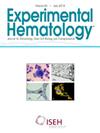Establishing a low-dose x-ray irradiation protocol for experimental acute graft-versus-host disease
IF 2.1
4区 医学
Q2 HEMATOLOGY
引用次数: 0
Abstract
The investigation of graft-versus-host disease (GvHD) after allogeneic stem cell transplantation heavily relies on the use of experimental animal models and total body irradiation (TBI) as a conditioning regimen. However, 137Cs is gradually being replaced as the main source of radiation due to safety concerns, and the transfer of established irradiation protocols to x-ray irradiators has proven difficult. Here, we describe the establishment of an x-ray–based irradiation protocol in an experimental mouse model for acute GvHD (C57BL6 → BALB/c). Our data show that commonly reported dosages of 6–9 Gy did not result in a viable model. Instead, irradiation with 5 Gy led to the development of clinical symptoms of GvHD in mice after transplantation with allogeneic bone marrow and T cells. Mice with GvHD displayed altered hemograms and increased serum levels of proinflammatory cytokines compared with mice without GvHD, which was accompanied by sequestration of donor lymphocytes within organs. Donor chimerism and hemogram analyses also indicated sufficient myeloablation and hematopoietic reconstitution. Overall, we show that low-dose x-ray TBI effectively promotes acute GvHD in a mismatched mouse model. We also propose that the transfer of previously established gamma-ray TBI protocols should be carefully evaluated according to individual circumstances.
建立实验性急性移植物抗宿主病的低剂量x射线照射方案。
同种异体干细胞移植后移植物抗宿主病的研究在很大程度上依赖于实验动物模型的使用和全身照射(TBI)作为调节方案。然而,由于安全方面的考虑,137Cs正逐渐被取代为主要的辐射源,而将既定的辐照方案转移到x射线辐照机上已证明是困难的。在这里,我们描述了在急性GvHD (C57BL6 → BALB/c)实验小鼠模型中建立基于x射线的照射方案。我们的数据显示,通常报道的6 - 9gy剂量不能产生可行的模型。相反,5 Gy的照射导致同种异体骨髓和T细胞移植后小鼠GvHD的临床症状的发展。与未患GvHD的小鼠相比,患有GvHD的小鼠表现出血象改变和血清促炎细胞因子水平升高,这伴随着器官内供体淋巴细胞的隔离。供体嵌合和血象分析也显示充分的骨髓消融和造血重建。总之,我们发现低剂量的x线TBI在不匹配的小鼠模型中有效地促进了急性GvHD。我们还建议,应根据个人情况仔细评估以前建立的伽玛射线TBI方案的转移。
本文章由计算机程序翻译,如有差异,请以英文原文为准。
求助全文
约1分钟内获得全文
求助全文
来源期刊

Experimental hematology
医学-血液学
CiteScore
5.30
自引率
0.00%
发文量
84
审稿时长
58 days
期刊介绍:
Experimental Hematology publishes new findings, methodologies, reviews and perspectives in all areas of hematology and immune cell formation on a monthly basis that may include Special Issues on particular topics of current interest. The overall goal is to report new insights into how normal blood cells are produced, how their production is normally regulated, mechanisms that contribute to hematological diseases and new approaches to their treatment. Specific topics may include relevant developmental and aging processes, stem cell biology, analyses of intrinsic and extrinsic regulatory mechanisms, in vitro behavior of primary cells, clonal tracking, molecular and omics analyses, metabolism, epigenetics, bioengineering approaches, studies in model organisms, novel clinical observations, transplantation biology and new therapeutic avenues.
 求助内容:
求助内容: 应助结果提醒方式:
应助结果提醒方式:


